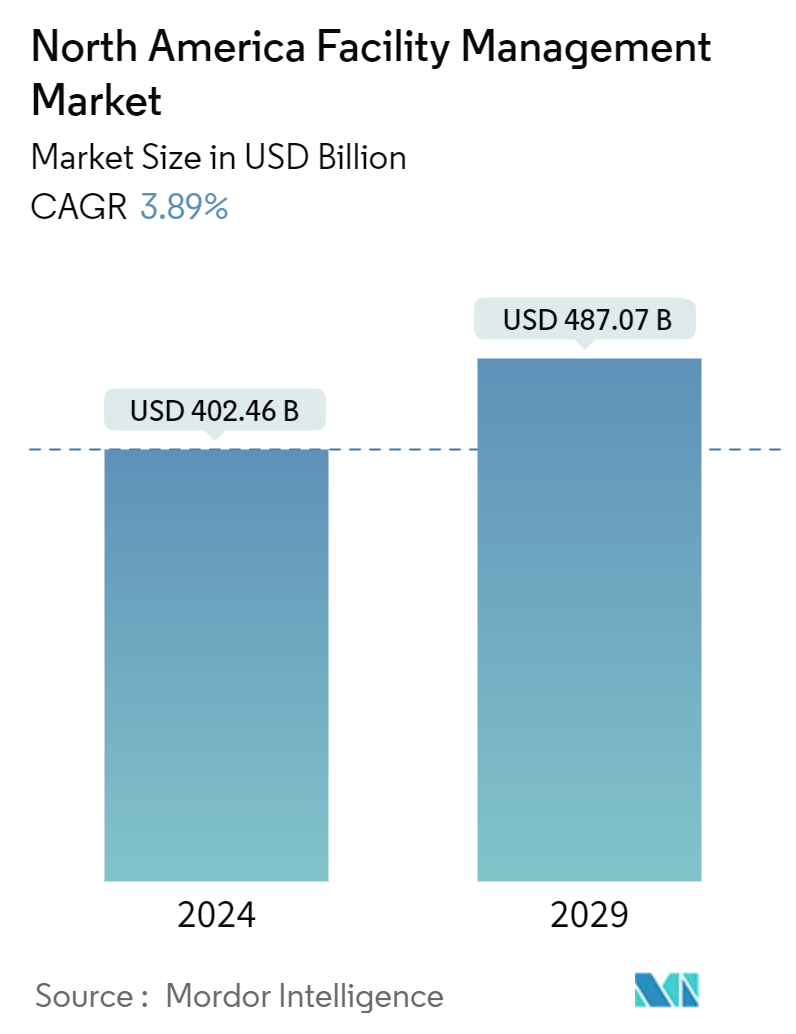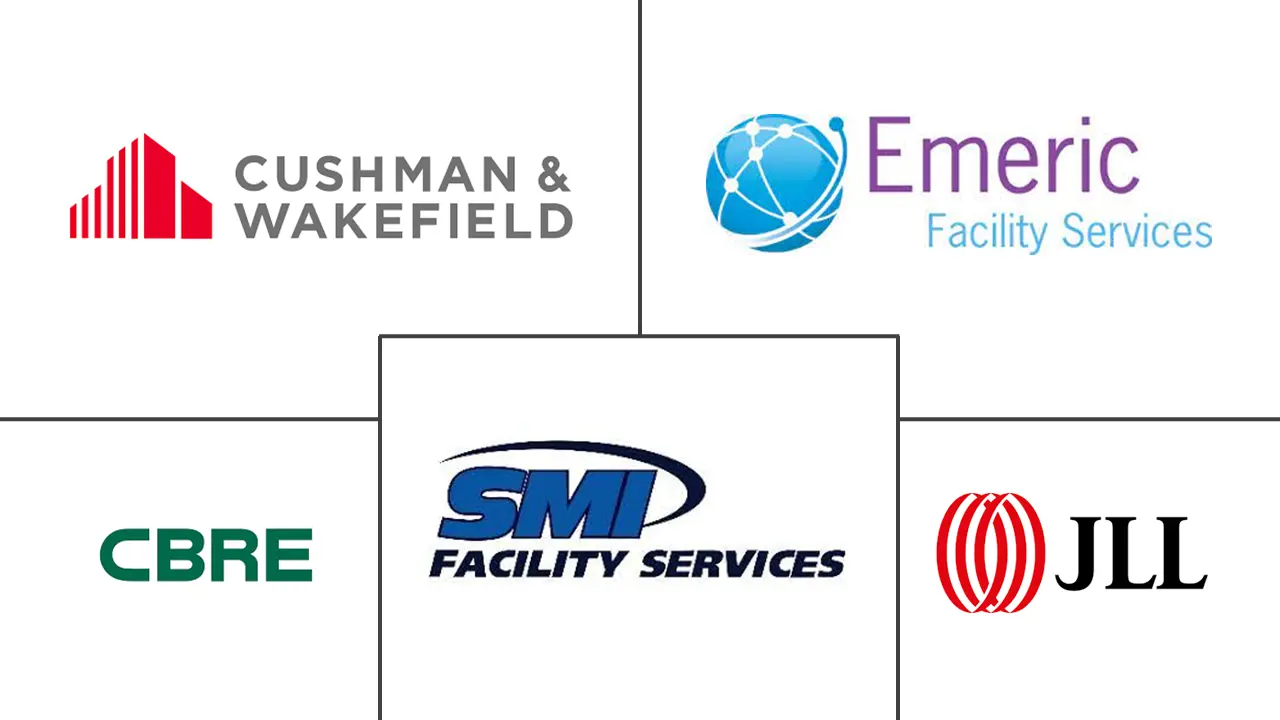Market Size of North America Facility Management Industry

| Study Period | 2019 - 2029 |
| Base Year For Estimation | 2023 |
| Market Size (2024) | USD 402.46 Billion |
| Market Size (2029) | USD 487.07 Billion |
| CAGR (2024 - 2029) | 3.89 % |
| Market Concentration | Medium |
Major Players
*Disclaimer: Major Players sorted in no particular order |
North America Facility Management Market Analysis
The North America Facility Management Market size is estimated at USD 402.46 billion in 2024, and is expected to reach USD 487.07 billion by 2029, growing at a CAGR of 3.89% during the forecast period (2024-2029).
Facility management consists of multiple factors that influence the productivity and efficiency of organizations. The new management system standard, conforming with the best industry practices, constitutes a benchmark for developing and driving effective strategic, tactical, and operational facility management (FM) principles across North America. Moreover, Facility management includes management methods and techniques for building management, infrastructure management for an organization, and overall harmonization of the work environment in an organization. This system standardizes services and streamlines processes for an organization.
- There are various trends that may propel facility management in North America; for example, the Internet of Things (IoT) refers to physical equipment and sensors that use the Internet to connect with FM teams. They generate performance data that alerts facility managers to potential problems. FMs can monitor and control equipment from any location. FM teams use IoT to deliver real-time insights into their operations. IoT paired with FM software, such as a computerized maintenance management system (CMMS), identifies problems (e.g., uncomfortable office temperatures), automatically prepares, and assigns work orders without human intervention, and tracks their execution.
- Further, the growth in construction activities is significantly boosting the demand for FM services in the region. For example, the rising population across the globe is increasing the demand for food and beverage industries. For instance, Biotics Research Corporation, a nutritional supplement maker, plans to spend USD 9 million to build an 88,000-square-foot warehouse, laboratory, and office facility in the United States and expects to complete it by 2023. Similarly, in June 2021, Darigold announced its plan to spend USD 500 million to build a 400,000-square-foot processing facility in the United States by the end of 2023. Such projects are expected to drive the demand for FM services in the country.
- The US government has recognized the importance of a clear strategy for industrial development. The country has been witnessing multiple industrial expansion activities, also expanding the scope of facilities management services. For instance, California's Petaluma is the first place to ban new gas stations, which means that there will be no new constructions of gas stations here. The city aims to become carbon neutral by 2030, to move in that direction. The city currently has 16 active gas stations for its 60000 residents.
- According to Mayor Teresa Barret, the city is taking one step at a time, gradually working towards change. The Mayor also said that the city did not make this decision to be the first; instead, it was a conscious decision to reach the carbon-neutral goal by 2030. A bill was passed with this new rule, and it is mentioned in the bill that the city does not require a new gas station as there are gas stations within a five-minute drive from every residence.
- On the flip side, the need for enterprises to evaluate possible cyber risks across their operational technology (OT) environments and take action to strengthen their security posture is more than ever as IT and OT systems continue to converge. Facility managers may offer crucial insider advice in developing and implementing a diligent cybersecurity plan to safeguard important OT systems as the threat landscape continues to change at an alarming rate.
- Cyber catastrophes can impact beyond financial loss; operational and reputational harm can be just as bad, if not worse. Facility managers and IT staff can better position themselves to make informed purchasing decisions, implement targeted OT security measures, and maintain increased cyber resilience across OT environments by knowing the cybersecurity concerns surrounding OT systems.
North America Facility Management Industry Segmentation
Facility management (FM) services involve the management of building upkeep, utilities, maintenance operations, waste services, security, etc. These services are further segmented by hard facility management services and soft facility management services. The adoption of FM solutions and services is likely to be driven by several factors, including an increase in demand for cloud-based FM solutions and a rise in demand for FM systems linked to intelligent software.
The North America facility management market is segmented by type (in-house facility management, outsourced facility management, (single fm, bundle fm, and integrated FM)), offering type (hard FM and soft FM), and end-user vertical (commercial, institutional, public/infrastructure, industrial, and other end-user verticals). The market sizes and forecasts are provided in terms of value in USD for all the above segments.
| By Type | |||||
| In-house Facility Management | |||||
| |||||
|
| By End-user Vertical | |
| Commercial | |
| Institutional | |
| Public/Infrastructure | |
| Industrial | |
| Other End-user Verticals |
North America Facility Management Market Size Summary
The North American facility management market is poised for significant growth, driven by the increasing complexity of organizational needs and the integration of advanced technologies. Facility management encompasses a broad range of services aimed at enhancing organizational productivity and efficiency, including building and infrastructure management. The adoption of new management system standards aligned with industry best practices is setting a benchmark for strategic, tactical, and operational excellence in the region. The market is further propelled by trends such as the Internet of Things (IoT), which enables real-time monitoring and control of facilities, and the rising demand for facility management services due to increased construction activities. These developments are supported by government initiatives and industrial expansion, which are expanding the scope and importance of facility management services across North America.
The market landscape is characterized by a moderate level of consolidation, with key players like CBRE Group, Inc., Jones Lang Lasalle Ip Inc., and Cushman & Wakefield Plc actively investing in strategic partnerships and service innovations to capture market share. The growing need for customized solutions, particularly in the commercial sector, is driving the demand for both hard and soft facility management services. The increasing focus on integrated facility management, coupled with the expansion of retail and commercial spaces, is expected to further fuel market growth. Additionally, long-term contracts and collaborations, such as those between Planon Corporation and Gilbane Building Company, are enhancing service offerings and operational efficiencies. As the market continues to evolve, the emphasis on energy efficiency, cybersecurity, and regulatory compliance will play a crucial role in shaping the future of facility management in North America.
North America Facility Management Market Market Size - Table of Contents
-
1. MARKET INSIGHTS
-
1.1 Market Overview
-
1.2 Industry Attractiveness - Porter's Five Forces Analysis
-
1.2.1 Bargaining Power of Suppliers
-
1.2.2 Bargaining Power of Buyers
-
1.2.3 Threat of New Entrants
-
1.2.4 Threat of Substitutes
-
1.2.5 Intensity of Competitive Rivalry
-
-
1.3 Analysis of the Macro Economic Trend
-
-
2. MARKET SEGMENTATION
-
2.1 By Type
-
2.1.1 In-house Facility Management
-
2.1.2 Outsourced Facility Management
-
2.1.2.1 Single FM
-
2.1.2.2 Bundled FM
-
2.1.2.3 Integrated FM
-
-
2.1.3 By Offering Type
-
2.1.3.1 Hard FM
-
2.1.3.2 Soft FM
-
-
-
2.2 By End-user Vertical
-
2.2.1 Commercial
-
2.2.2 Institutional
-
2.2.3 Public/Infrastructure
-
2.2.4 Industrial
-
2.2.5 Other End-user Verticals
-
-
North America Facility Management Market Market Size FAQs
How big is the North America Facility Management Market?
The North America Facility Management Market size is expected to reach USD 402.46 billion in 2024 and grow at a CAGR of 3.89% to reach USD 487.07 billion by 2029.
What is the current North America Facility Management Market size?
In 2024, the North America Facility Management Market size is expected to reach USD 402.46 billion.

